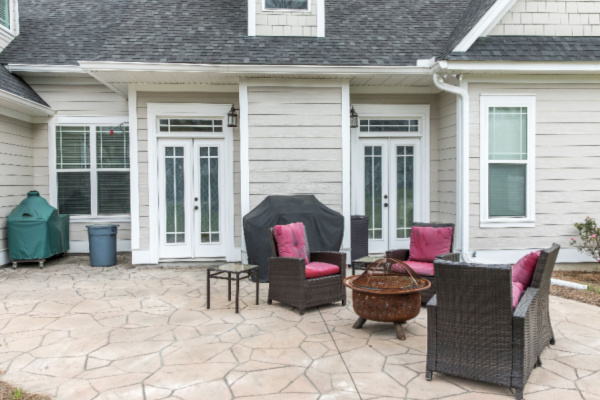As US News reports, stamped concrete is an affordable, long-lasting option for homeowners looking to enhance their home’s curb appeal. The color and pattern options are nearly endless, giving your patio or driveway the high-end look of stone, wood or brick pavers. Before choosing stamped concrete, compare the pros and cons to decide if it’s the right choice for your patio or driveway.
What Is Stamped Concrete?
Stamped concrete mimics the look of stone and other materials, such as slate, brick, flagstone and even wood, explains Sarah Hutchinson, director of digital content at The Concrete Network. “Contractors use special stamps to add texture and pattern to the surface of fresh concrete,” Hutchinson says. Stamped concrete is becoming an increasingly popular choice among homeowners, offering a more affordable alternative to higher-end materials. This process can be used on concrete patios, driveways, walkways, pool decking and retaining walls.
“One of the best things about stamped concrete is that it comes in many different patterns, textures and colors,” says Bailey Carson, home care expert at Angi. “For driveways, most homeowners choose designs that look like other driveway materials, like pavers, natural stone tiles, cobblestone or brick. For patios, homeowners tend to go more for wood plank or brick designs.” Hutchinson adds that color can also be used in the concrete mixture or applied during the stamping process. For an authentic look, multiple colors are applied to imitate natural variations.
Although the options are limitless, Carson says a local driveway paving contractor or stamped concrete patio company will be a great resource for helping you decide what’s best for your home.
The Pros
- It’s more affordable. Stamped concrete is typically more affordable than natural stone, brick or pavers, Hutchinson explains. Installation costs for pouring and stamping concrete are also much lower than they would be for other materials.
- It can be customized. One of the biggest advantages that attracts homeowners to using stamped concrete for patios or driveways is that it’s extremely customizable. “You get to personalize every aspect of your stamped concrete, including colors, textures and patterns. Stamped concrete is excellent at mimicking other materials, like natural stone, cobblestone, brick, pavers, slate slabs, wood planks and floral patterns,” says Carson.
- Durable and easy to maintain. Regular sweeping, blowing and rinsing with a hose is usually enough to keep a stamped concrete patio or driveway clean. Stamped concrete is also very durable if it was properly installed and maintained, and able to withstand a wide range of weather conditions.
- Adds to home value. By working with a professional, homeowners can find a color and pattern that enhances the aesthetic appeal of their patio or driveway.
The Cons
- It can crack. Stamped concrete is durable, but like any other concrete, it doesn’t last forever. “Stamped concrete can crack in cold temperatures, especially if there are heavy cars weighing it down,” Carson says.
- It’s not DIY-friendly. The process of pouring and stamping concrete requires expertise and special tools, and may not be the best DIY project. Professionals have the knowledge and experience to mix and prepare concrete and once it starts to harden, any mistakes can be difficult to fix.
- It can be damaged. Stamped concrete can be damaged by freeze and thaw cycles, as well as from deicing salts during the colder months, Hutchinson warns.
- Repairs can be difficult. Defects or poor workmanship on stamped concrete can be difficult to repair. Carson also says that it can also be difficult to find a color or texture match when it comes time to repair or replace your patio or driveway.
How Much Does Stamped Concrete Cost?
“Stamped concrete is typically more affordable than the material it’s mimicking, especially materials like pavers or natural stone,” Carson says. But like most home improvement projects, costs vary widely depending on where you live and what you select. According to Hutchinson, basic stamped concrete with one pattern and color starts around $8 per square foot. If you choose a more intricate design with multiple colors and a higher-priced sealant, then prices can be $18 or more per square foot.
Does Stamped Concrete Improve a Home’s Resale Value?
“With stamped concrete, you’ll get a surface that lasts longer and requires less maintenance than most other materials, which can add up to big savings over its lifetime,” Hutchinson explains. “You’ll also add curb appeal and aesthetic value to your home, allowing you to maximize the return on your investment.” According to US News, stamped concrete is also low maintenance compared to other materials, but it’s important to keep it clean. Resealing your patio or driveway every two to three years, which Carson says can cost between $1,250 and $1,750, can also help prevent stains and weather damage. Maintenance and repair costs can affect what you’ll be able to recoup when or if you decide to sell, but installation costs can typically be recovered.
—
Photo Credit: Ursula Page / Shutterstock.com
